
Nippon2
.pdf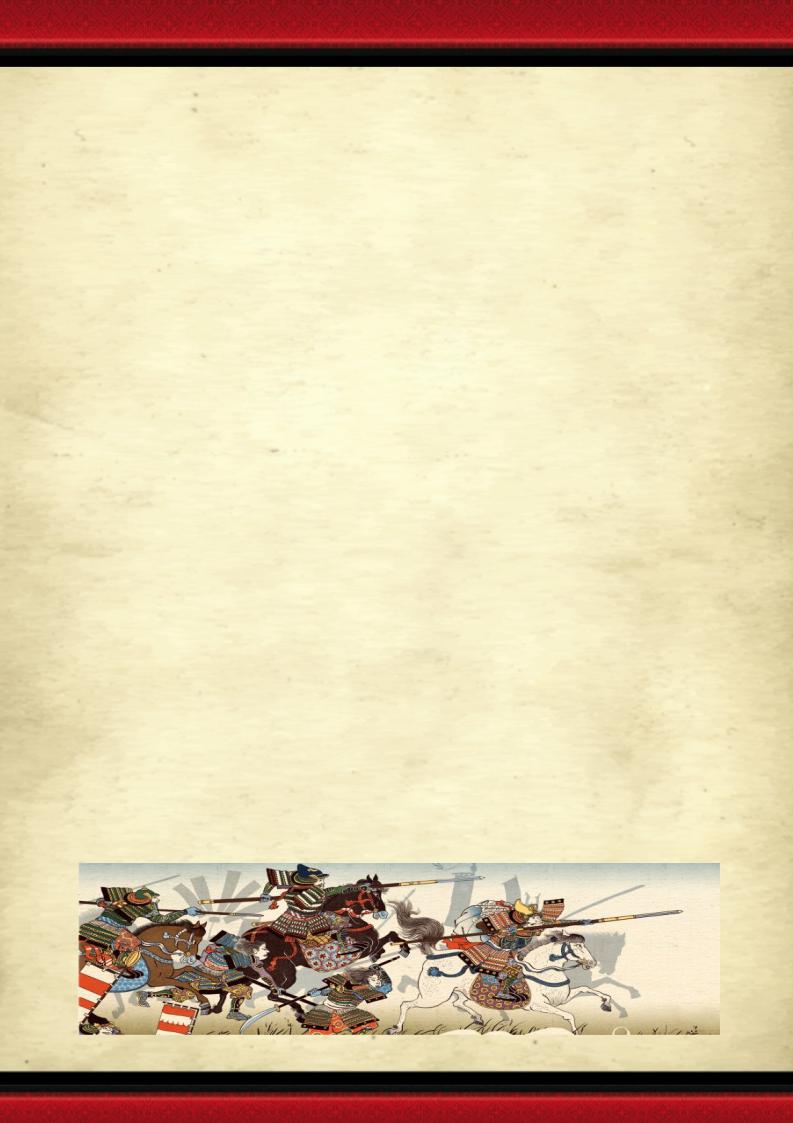
ARMY SPECIAL RULES
This section of the book describes all the different units used in a Nippon army, along with any rules necessary to use them in your games of Warhammer. Where a model has a special rule that is explained in the Warhammer rulebook, only the name of that rule is given. If a model has a special rule that is unique to it, that rule is detailed alongside its description. However, there are a number of commonly recurring ‘army special rules’ that apply to several Nippon units, and these are detailed here.
WAY OF THE WARRIOR
The Warriors of Nippon have a strict code which they live by. Anyone breaking this code is forever shamed and cast out of society. As a result, the warriors of Nippon fight with unmatched determinism and valour.
Models with this rule must always accept challenges and re-roll all failed Psychology tests. In addition, they ignore Panic caused by friendly units without this rule.
KENJUTSU
Kenjutsu is the art of sword fighting practiced by the Samurai of Nippon. This allows each warrior to quickly follow up a successful attack with another, overpowering their foes in a flurry of fast swings.
Each unsaved wound caused by a model with this special rule generates an additional attack in Close Combat. These additional Attacks do not generate extra Attacks.
DEATH BEFORE DISHONOUR
When a Samurai is defeated in battle, thus dishonouring himself, he may choose to perform seppuku on the battlefield to cleanse himself of his shame, or to avoid being captured as a prisoner.
When a unit with this special rule breaks from combat, the unit may choose to perform seppuku instead of fleeing. If this is done, remove the entire unit immediately. The enemy may not make a pursuit or overrun move, but may reform as normal.
Units that perform seppuku do not cause Panic to units with the Way of the Warrior special rule.
SAMURAI EQUIPMENT
KATANA
There is no weapon so revered as the katana. Three to four feet in length and slightly curved, the katana is a triumph of design, the midpoint between artistry and craftsmanship.
Specially forged so that the blade is hard and the inside is soft, the katana combines a devastating cutting edge with enough flexibility so as to not shatter when cutting into armour or bone.
While the wakizashi may only be worn by those of the samurai caste, only warriors carry the katana. Families pass the swords down through generations; carrying a famous katana is an honour and pledge. A katana is not only a weapon of war; it is an expression of the soul of its bearer.
The Katana counts as a hand weapon. The wielder may choose to use it as a two handed weapon which requires two hands. If he chooses to do so, he may reroll 1's To Hit in close combat.
SASHIMONOS
Sashimono are small banners worn by Nipponese soldiers for identification during battles. The sashimono are usually fitted to the backs of Ashigaru, samurai, and in special holders on the horses of some cavalry soldiers.
A unit equipped with Sashimonos counts as having one more rank than normal for purposes of Steadfast and Combat Resolution, up to a maximum of 4+.
HORO CLOAKS
Horo Cloaks are stiffened cloaks fashioned of finely woven silk and wrapped around the body. Their primary purpose is to improve the visibility of the wearer on the battlefield, but they also serve as arrowcatchers.
Any shooting attack directed at a model equipped with a Horo Cloak is resolved at -1 Strength. Horo Cloaks have no effect against black powder weapons or Flaming Attacks.
51
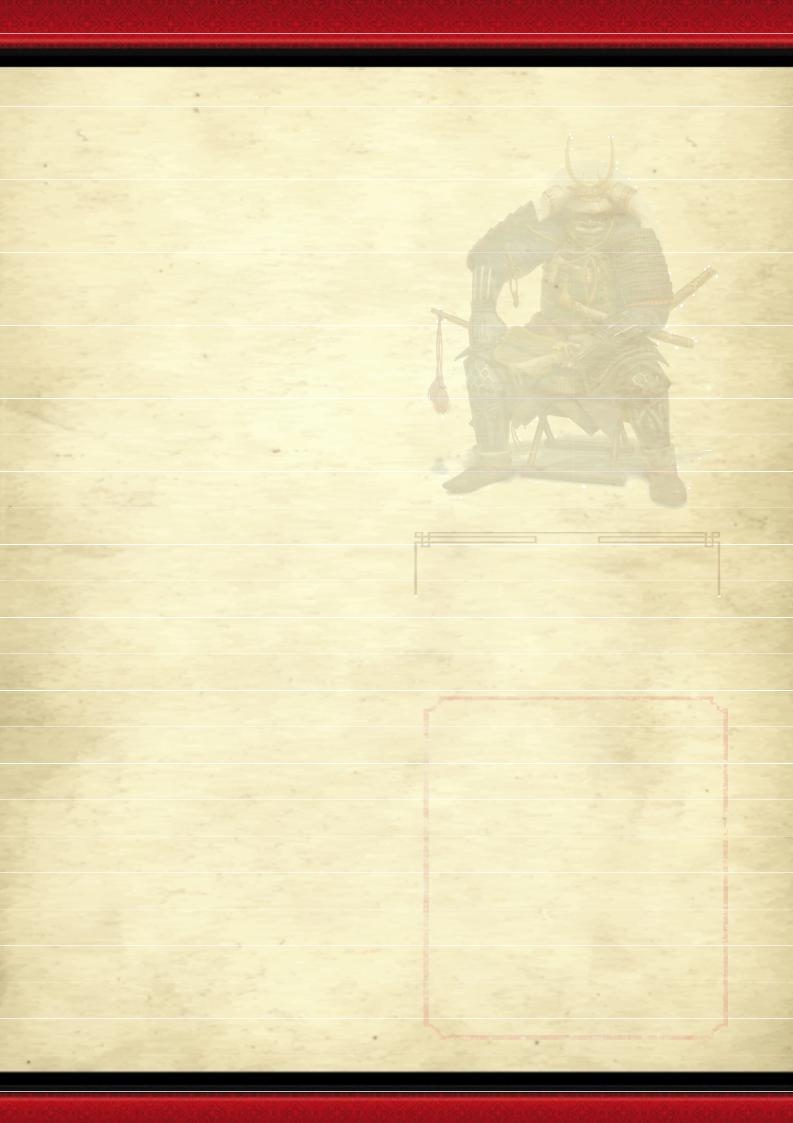
C OMMANDERS
The Daimyo are the feudal lords of Nippon, outranked only by the Shogun and the Imperial fa mily. Daimyo have almost total autonomy in the day-to-day running of their territory, and it is therefore unsu rprising that civil strife is common as Daimyo fight over resources and pursue personal vendettas. Though bound by the Way of the Warrior like all Samurai, D aimyo tend to be more pragmatic about its application as they involve themselves in the politics of the Empire.
Although the Emperor owns all land within the borders of the Empire, he has granted members of the samurai class the honour of protecting and overs eeing his affairs, acting as his stewards over the v ast majority of land in the Empire. Samurai that have oversight of a particular area are granted the title "Daimyo" and given permission to swear other samurai into their service. Rather than serving the Emperor directly, a Daimyo of this sort is usually appointed by and sub ordinate to the reigning Daimyo of the family or clan t hat controls the province within which his land falls.
The primary responsibilities of a Daimy o of this sort are protecting his assigned territory and ensuring that the proper taxes are collected for the E mperor. In order to fulfil these responsibilities he is allo wed to take a portion of the rice and other goods produced in his province in order to equip and maintain samurai sworn to his service.
Each family recognized by the Emperor has a designated leader who is Daimyo of that family. Family Daimyo are the highest authorit y within their own family, although they are subordinate to the Daimyo of their clan.
Family Daimyo are also the honorary h eads of their family's schools. The actual duties of running the schools are often delegated to someone more inclined to teaching, or in the case of families w ith multiple schools, someone who is more familiar with the lessons. Nevertheless, for any matter th at would require the attention of the head of the school, the family Daimyo's approval would be required, whether or not he has an active hand in the scho ol's day to day affairs.
The leader of a clan, whether a Great or Minor clan, is also given the title Daimyo, although they are more often referred to as the Champion of the clan. The clan Daimyo are generally also the Daimyo of their family within the clan. The clan Daimyo are the most powerful in the Empire, second only to the Emperor and Shogun, in both political and military might.
Taisho is a military rank similar to a ca ptain. A Taisho will have many Chui and their units ser ving beneath him, and reports directly to the Daimyo, who command the force in which the Taisho serves.
|
M WS BS S T W I A Ld |
||||||||
Daimyo |
4 |
6 |
5 |
4 |
4 |
3 |
6 |
4 |
9 |
Taisho |
4 |
5 |
5 |
4 |
4 |
2 |
5 |
3 |
8 |
TROOP TYPE: Infantry ( Character).
SPECIAL RULES: Way of the Warrior,
Kenjutsu, Death before Dis honour.
The Ten Orders
•A leader always carries a text with him.The mind must be exercised as well as the body.
•When a lord called his samurai, he ran, fall at his feet and spoke his name loudly and proudly.
•Keep one's sword close and ready and clean.
•Keep servants only if necessary.
•Lady Sun and Lord Moon made a samurai with a left hand and a right hand. In the left hand went the text and in the right hand went the sword.
•When a samurai came before a superior, he dropped hands at his sides, and bow ed lower than they, showing trust.
•Men followed the example of those they admired.
•A samurai went to bed early, then, at midnight he would be fresh, rested and ready for any foe who creeped in late hours.
•Be clean, because a dirty man must itch and scratch, and an itching and scratching man was slow.
•Be ready to die.
52

SHUGENJA
Most armies keep at least one Shugenja on hand, both as a potent weapon against the enemy and to call upon the blessings of the Fortunes for the battles ahead.
Once the battle is done, they give thanks to the Kami and purify the taint of blood and dead flesh that inevitably stains a victorious army.
Shugenja stand out as the one exception to the samurai's usual aversion to surrender. A s servants of the Kami, they are always treated with r espect and offered the option of being taken prisoner when possible. Most Shugenja realize how ra re and precious their gift is, and how wrong it would be to deny the clan their gifts, and accept the offer even if the idea of being held hostage is otherwise intolerable.
Magic in Nippon, is not simply a Shugenja bending the elements to her will, magic underlies al l activities: the bird taking flight, and the Sun rising ea ch morning. Man too comes from the confluence this magic projected in the blood and tears of the fi rst Moon and Sun mixing together to create somethin g new. Magic spirits dwell everywhere, simply waiting to be called upon.
In a more common definition, however, magic is the art of Shugenja, and even the monk's kiho. While the average Nipponese understands that magic surrounds them every day, it is still a holy practice , and something to be looked upon with wond er. Shugenja, the most common practitioners of magi c, bring with their vocation the blessings of the Kami upon the Empire.
53
The samurai caste holds the keys to the magic realm, proof that the greatest blessi ngs of the Sun and Moon are reserved for the nobility. Occasionally, peasants have a strong affinity for the Kami and in all but the rarest cases this is the same inner path that the monks follow. The peasant then goes on to study among the peaceful Brotherhood of Shi nsel. Peasants who show true magical affinity are quic kly granted samurai status and trained as Shugenja.
As a force, magic represents a tool and a blessing as a genuine gift from the Heave ns. With the power of magic, a Shugenja can purify foul water, tell truth from fiction, hurl fire into their enemies, and convene with the wisdom of the Celestial Heavens. This immense power commands respect both for the Shugenja who wields it, and for the Kami w ho provide such strength.
Shugenja do more than simply cast spells. They are the priests of the Kami, their very power a testament to the wisdom and truth of their be liefs. Shugenja record and keep the names of the Fortun es, act as intermediaries between the world of mortal s and spirits, and carry the wisdom set down by the Cel estial Heavens. Though not the official keepers of th e Tao of Shinsei, a duty held by the Brotherhood of S hinsei monks, almost all Shugenja are familiar with th e text, and view it as a valuable guide to life.
Shugenja bless villages man y times during a year, to help bring about a greater harvest, healthier livestock, and protect the village again st threats both mortal and supernatural. They also com mune with spirits of the dead, creating a link between the living and the revered ancestors of the family. Such a duty falls to them as both a great honour and a staggering burden. as many souls of the dead are trouble d with unfinished business, and will seek a Shugenja's aid in fulfilling It in return for their wisdom.
Shugenja tend be peaceful men. While most clans have their Shugenja trained for wa r and capable of casting impressive battle magic, the path of the Fortunes and Kami impresses a Shugenja with a strong reverence for life in all its forms. Shugenja believe life is a gift, and should never be squandered for any reason.
|
M WS BS S T W I A Ld |
||||||||
High Shugenja |
4 |
3 |
3 |
3 |
3 |
3 |
3 |
1 |
8 |
Shugenja |
4 |
3 |
3 |
3 |
3 |
2 |
3 |
1 |
7 |
TROOP TYPE: Infantry ( Character).
MAGIC: A Shugenja is a Wizard that uses spells from the Lore of Fire, Lore o f the Heavens, Lore of Life, Lore of Shadow or Lor e of the Kami.
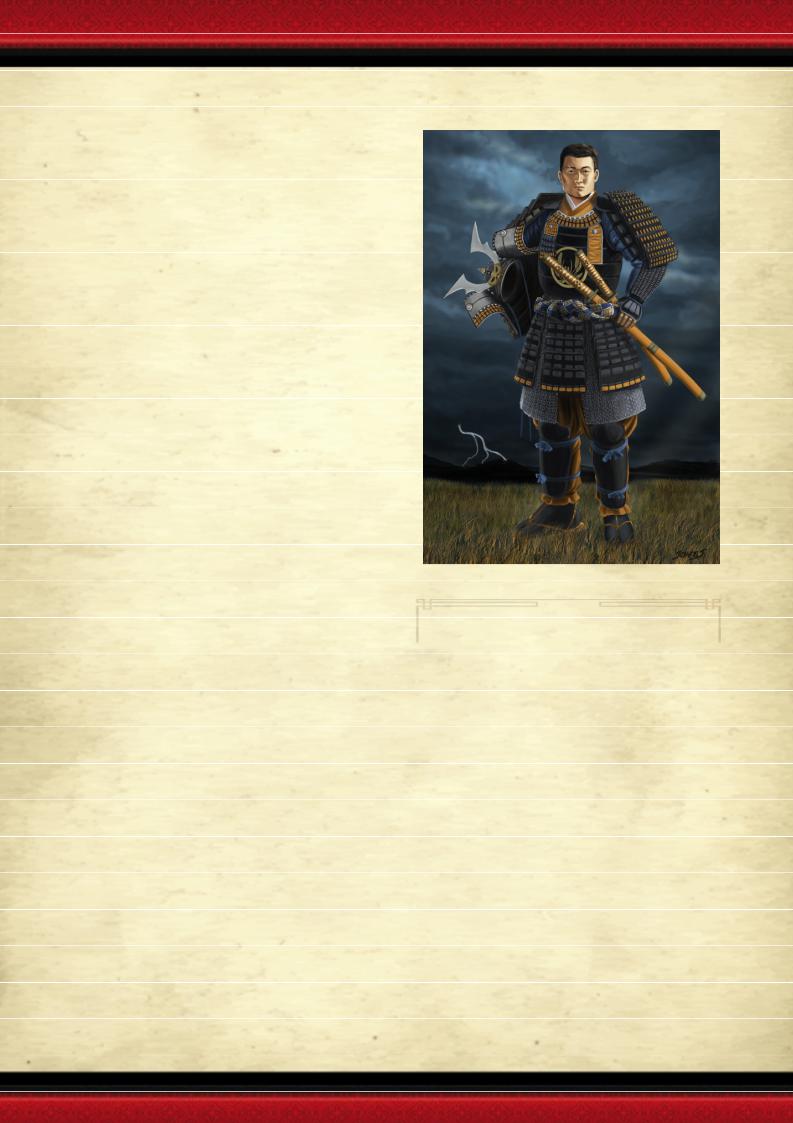
HATAMOTO
Those Samurai that distinguish themselves on the battlefield become part of a Clan’s inner circle in the form of Hatamoto.
A Hatamoto, or honoured retainer, is the official representative of the family name. It is t he chief aid and advisor to a daimyo.
The position commands great respect a nd influence, as the daimyo has chosen the individual for this task. When a daimyo travels, it is common fo r the Hatamoto to be left in charge of the daimyo's estate. To be a hatamoto means his lord regards his adv ice highly, and the title is so that all will know he is on e of his favoured subjects. Sometimes the title b rings with it a certain amount of land, where the hatam oto is expected to live and continue in the service of the ir lord. Hatamoto are similar to military titles, in the way that they bring great responsibility and glory .
In the absence of his lord he can speak with authority on his behalf, and even to agree minor c ontracts and negotiations for their family.
Many of the Hatamoto spend their time perfecting their fighting skills and cultivating a full rang e of meditative and artistic disciplines, and many Hata moto have brought honour to their clan as poets or painters.
One of the first recorded Hatamoto in history was Mirumoto, who became the Hatamoto o f the Kami Togashi. Around this time was also the founding of the Shiba Yojimbo School, which was inspired by the Kami Shiba kneeling before Isawa and pledging to protect the Shugenja and his tribe.
The main duty of the Hatamoto on the b attlefield is to protect important members or allies wh o were not expected to always defend themselves. People such as courtiers and Shugenja were most com monly not trained in the sword, and as such would require someone to protect them. In the case of duels of honour, a Hatamoto can often be someo ne’s designated champion, although this is not necessari ly always the case.
At other times, the Hatamoto is usually assigned the carry his lord’s banner into battle as his personal champion. These glorious standards are rich in colour and highly detailed, made from the finest silk available. The Hatamoto takes this honour very seriously, and would rather die than see it fall into enemy hands.
Above else, the Hatamoto acts as the D aimyo’s bodyguard, both on the battlefield and in the castle. The Hatamoto take his given task extre mely serious, for to them there is no greater shame th an failure. Failure to protect the one they have swo rn means their life is forfeit, and there is no other solution than to take one’s own life, for a life in shame is co mpletely unthinkable to them.
|
M WS BS S |
T W I A Ld |
|||||||
Hatamoto |
4 |
4 |
4 |
4 |
4 |
2 |
4 |
2 |
8 |
TROOP TYPE: Infantry ( Character).
SPECIAL RULES: Way of the Warrior,
Kenjutsu, Death before Dis honour.
Yojimbo: A Hatamoto may be assigned as a yojimbo, meaning bodyguard, to one c haracter in the army. While in base contact with th is character, all failed “Look Out, Sir” hits are taken by the Hatamoto instead of the character, and all chall enges issues by enemies are taken up by the Hatamot o.
If the character the Hatamoto is assigned to protect dies, the Hatamoto will immediately commit seppuku as per the Death before Dishonour special rule.
Each character that survives the game with a Hatamoto assigned to it as a Yojimbo g ives the Nippon player an additional 50 Victory points.
A character may only have one Yojimbo assigned to it at any time, although a new Yojimbo may be assigned upon the death of another Ha tamoto.
54
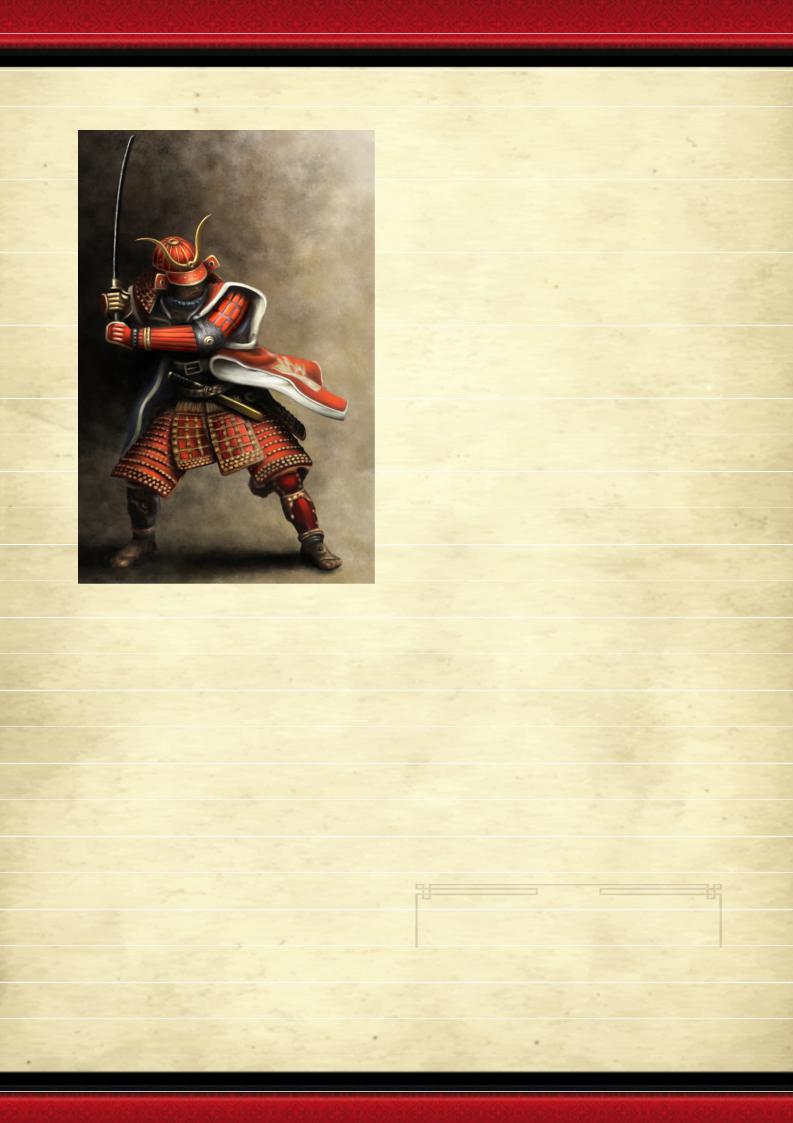
SAMU RAI WARRIORS
The Samurai assume the highest rank o f the Nipponese social system, as decreed by the Celestial Order. The word "samurai" means "those who serv e". All who were born in this caste were considered samurai, regardless of their occupation. The Samurai warriors make up the bulk of Nippon’s armies. G reatly skilled with both sword and bow, and wearing heavy armour, often with accompanying battle masks, these fearsome fighters are a match for any opponent.
The Samurai wield a variety of equipm ent in battle, and can adapt to any situation. They rep resent the height of human martial prowess, and fi ght according to a strict code of honour, displaying fa natical bravery and loyalty on the battlefield.
Unlike Old World nobles, samurai tend to live frugal lives with little interest in riches and ma terial things, but rather in honour and pride, though as privileged persons in society much of their needs a re supplied, and respect and honour fearfully enforced.
Samurai are expected to not only be great warriors but to be well versed in more classical arts such as calligraphy, mathematics, and song and dance. However, it is often the case that these pursuits are overlooked.
Though it is their duty to wear the daish o and lead troops into combat, samurai are more th an mere
55
warriors. They are direct vassals of the Emperor, the ruling class of the Empire. The kuge and buke classes enforce the law of the Emper or, and hold domain over the lesser classes.
Samurai are professional wa rriors, members of the noble class who are trained in the arts of warfare. They are not only trained for their role in society, they are born for it – born into a syste m of allegiance, loyalty, and honour that influences e very stage of their lives. A samurai's loyalty to the empe ror and his local feudal lord is unsurpassed, and a sa murai that becomes masterless either from the ruin or fall of his master, after the loss of his master's favour or privilege, or otherwise through his own w ill becomes a Ronin, an outcast mercenary for hire.
A samurai's first responsibility is obedience to his lord, usually the head of his famil y. This is simultaneously an endless source of adventures and a potential hindrance to a life of advent ure. A low-level samurai's lord may command him to in vestigate a mysterious occurrence or subdue a gang of bandits. If he performs these duties well, his lord will call on him to deal with more significant problems. H owever, a samurai usually cannot simply disappear on a n expedition without his lord's command or at least p ermission, and if a samurai's lord has an import ant mission for him, he must make that his top priority.
Samurai are distinguished fr om ordinary fighters by their adherence to bushido, a code of honour, loyalty, and obedience. To a samurai, dishonour is worse than death, and the loss of his sw ords is possibly the worst dishonour imaginable.
Bushido, the code of the sam urai, demands strict obedience to standards of behaviour and honour. Samurai learn their combat techniques and the principles of bushido in esta blished, well-organized schools.
The only measure of a samur ai that matters is living life in strict accordance with the code of bushido. This ancient code was established during the dawn of the Empire, and although the interpretation of the individual virtues it describes has changed from time to time, the code itself has endu red the centuries virtually unchanged.
|
M WS BS S T W I A Ld |
||||||||
Samurai Warrior |
4 |
4 |
4 |
3 |
3 |
1 |
4 |
1 |
8 |
Samurai Chui |
4 |
4 |
4 |
3 |
3 |
1 |
4 |
2 |
8 |
TROOP TYPE: Infantry.
SPECIAL RULES: Way of the Warrior,
Kenjutsu, Death before Dis honour.
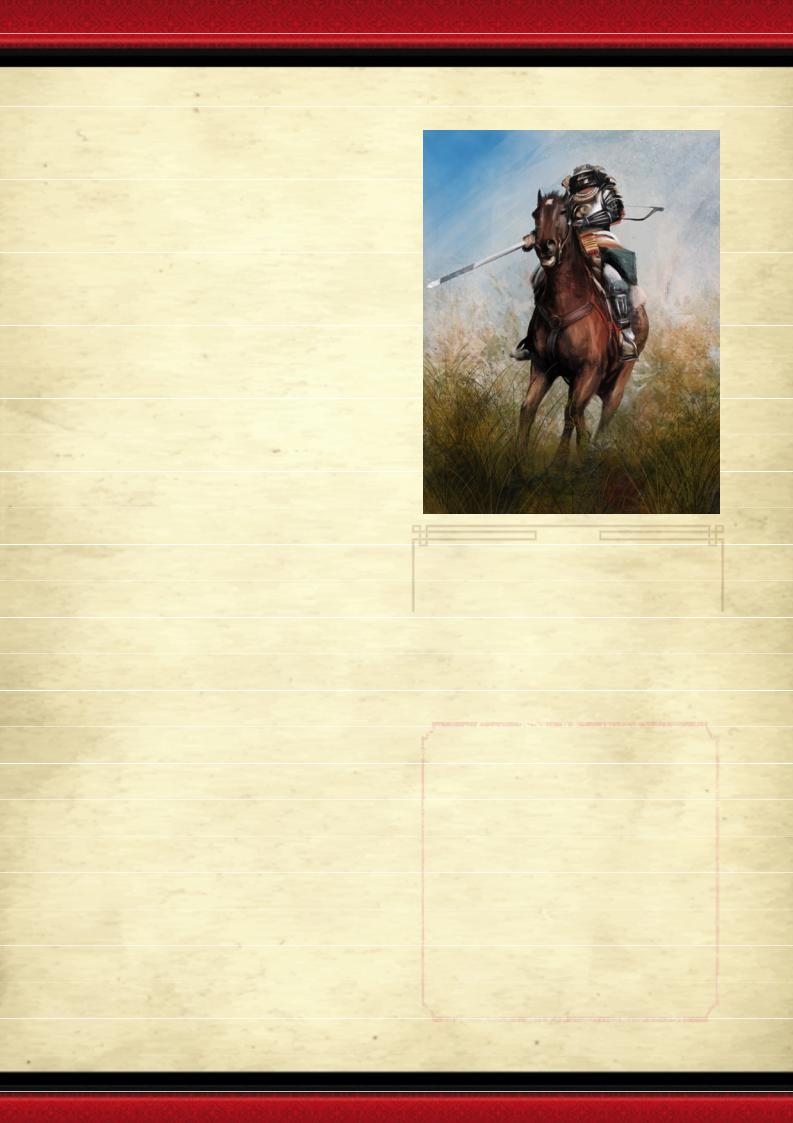
SAM URAI CAVALRY
Cavalry warfare is traditionally the preserve of the samurai. Only they have the skill to wi eld a sword while steering a horse into battle. Being a mounted warrior requires wealth and position to sustain the expense of horses, armour and servants.
Despite the fact that most Samurai go a bout their business mounted, generally merely as a sign of their station, only a very few have truly perfe cted the art of war from horseback.
The mounted Samurai are truly deadly warriors and the scourge of any commander foolish enou gh to incur the wrath of a Nipponese army. They eschew the heavy plate armour and cumbersome barding f avoured by the knights of the Old World in favour of in creased speed and flexibility. They attack in combination with infantry, using their excellent horsemanship to outmanoeuvre and strike the enemy fro m multiple directions at once.
Bows, spears and katana are all used fro m horseback and, if a samurai is wealthy enough, he usually has an assistant to carry and hand him his wea pons as needed. The katana, although traditionally used with two hands, can still be effective when used in a one -handed grip by a horseman. Swung downwards onto an enemy foot soldier, the sharp, curved blade could e asily cut through a man.
Samurai Cavalry are swift, and can deliver a devastating charge thanks to their spears, which they focus all the power of their fearsome charge into the points of as they smash into enemy cav alry and infantry alike. Samurai cavalry are extr emely well trained and the weight of their steeds ad ds to the power of their charge.
Their speed over a battleground comes in useful when chasing down fleeing troops, or when th ey are needed to deliver a final blow to wavering ene mies.
After a charge, they remain mounted and can engage the enemy with their katana keeping a height advantage over foot soldiers.
Samurai Cavalry demoralise, harass, and cut down the enemy ahead of the foot soldiers.
Units of specially trained mounted sam urai are also famous for running daring night time raids on enemy camps and fortifications, using their lig htly armoured horses to cross rivers and move quickly through woods and mountains, before striking at the fla nks of an unprepared enemy.
One of the most famous cavalry charge s was seen at the Battle of Xenyong, where the Nippo nese cavalry charged straight into the Cathayan formations through a rain of crossbow bolts and steel tipped spears. Even though the Nipponese suffered horrible casualties, their unwavering morale managed to break t he Cathayan formation, securing victory against the Cathayans.
|
M WS BS S T W I A Ld |
||||||||
Samurai Cavalry |
4 |
4 |
4 |
3 |
3 |
1 |
4 |
1 |
8 |
Samurai Chui |
4 |
4 |
4 |
3 |
3 |
1 |
4 |
2 |
8 |
Warhorse |
8 |
3 |
0 |
3 |
3 |
1 |
3 |
1 |
5 |
TROOP TYPE: Cavalry.
SPECIAL RULES: Way of the Warrior,
Kenjutsu, Death before Dis honour.
A Samurai's Purpose
A samurai keeps in mind and heart the understanding that he must die.
Surrendering to ambition, lust, greed, or any other thing, a samurai will hesitate for that one crucial moment when it comes time to sacrifice his life for his lord.
Samurai live, train to fight and fight to live. Only alive can a samurai fulfil his Duty and protect his lord. Duty beyond all things is the soul of a true samurai. Living to fulfil Duty is why a samurai forego ambition, abstain from lust, and sacrifice his personal morals.
56
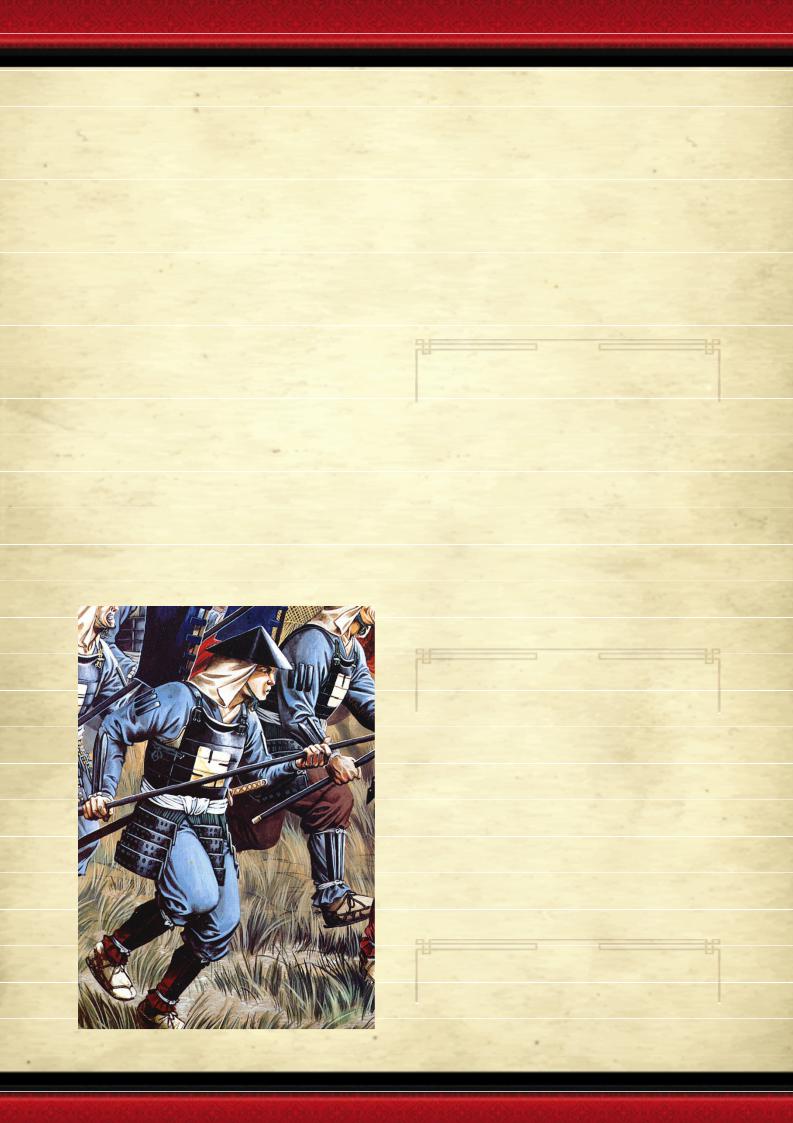
ASHIGARU
The absolute lowest ranking members o f the buke are Ashigaru, or career soldiers. Technically peasants, they possess far keener training than the ave rage peasant or carpenter. While hardly comparable to samurai by any stretch of the Imagination, Ashigaru are skilled warriors in their own right. Many Ashig aru families have served their samurai lords for gene rations, and bear themselves with fierce pride and lo yalty comparable to samurai. Most houses have several families of hereditary Ashigaru, serving as guardsmen, doshin (soldiers serving magistrates), a nd scouts during times of peace.
The majority of most Nipponese armies are composed of Ashigaru. Unlike the levies of the Old World though, the Ashigaru are armed with hi gh quality weapons and are well drilled for battle. Though they cannot equal the martial prowess of thei r Samurai masters, they are effective troops. Their preferred armament is the yari spear, but they ma y also march into battle with the yumi bow and the m atchlock arquebus.
Ashigaru occasionally prove to be deadly when given sufficient direction and purpose by a competent leader. After all, arrows in sufficient numbers may maim or even kill the most highly trained, armed , and armoured bushi before he gets close enough to ev en wound anybody. Even then, however, most sam urai look upon the Ashigaru as mere tools: as Tsuruchi Nobumoto says, "What we do is art. What peasants do is merely adequate."
57
ASHIGARU SPEARMEN
The yari is a remarkably flexible weapon in tactical terms. It can be used in single or mass combat and is equally effective for attack and defence. Yari Ashigaru are armed with very long spe ars that are almost pikes, and can be used to lead a cha rge into battle or act as pincers. They are well-drille d, but lack the skill and dedication of samurai. Yari Ashigaru are most effective when they work together as a block, forming a wall of sharp points. The yari is the most common weapon issued to Ashigaru, which they use in formation, particularly against cavalry c harges.
|
M WS BS S T W I A Ld |
||||||||
Ashigaru |
4 |
3 |
3 |
3 |
3 |
1 |
3 |
1 |
6 |
Yari Gashira |
4 |
3 |
3 |
3 |
3 |
1 |
3 |
2 |
6 |
TROOP TYPE: Infantry.
SPECIAL RULES: Fight in Extra Ranks.
ASHIGARU BOWMEN
These soldiers do not possess the prowess or prestige of samurai archers, but they are still a formidable force. Perhaps surprisingly, Ashigaru bowmen were not made obsolete by the arrival of gu ns. While gunners reload, archers can continue to fire arrows, provide cover and maintain the pressure on an e nemy. In the same time it takes to fire and reload a firearm once, these archers can let loose a dozen arrows upon the enemy.
|
M WS BS S T W I A Ld |
||||||||
Ashigaru |
4 |
3 |
3 |
3 |
3 |
1 |
3 |
1 |
6 |
Yumi Gashira |
4 |
3 |
4 |
3 |
3 |
1 |
3 |
1 |
6 |
TROOP TYPE: Infantry.
MATCHLOCK ASHIGARU
Estalian merchants arriving in Nippon sold handguns to the Nipponese, and it didn't take long for them to produce their own designs. T he role of matchlock Ashigaru is to unleash masse d gun volleys upon the enemy, keeping them confused and, in the process, weakening them enough for a frontline charge. Once fired, the guns take a long ti me to reload, but their hitting power more than com pensates for this lack of speed.
|
M WS BS S T W I A Ld |
||||||||
Ashigaru |
4 |
3 |
3 |
3 |
3 |
1 |
3 |
1 |
6 |
Teppo Gashira |
4 |
3 |
4 |
3 |
3 |
1 |
3 |
1 |
6 |
TROOP TYPE: Infantry.
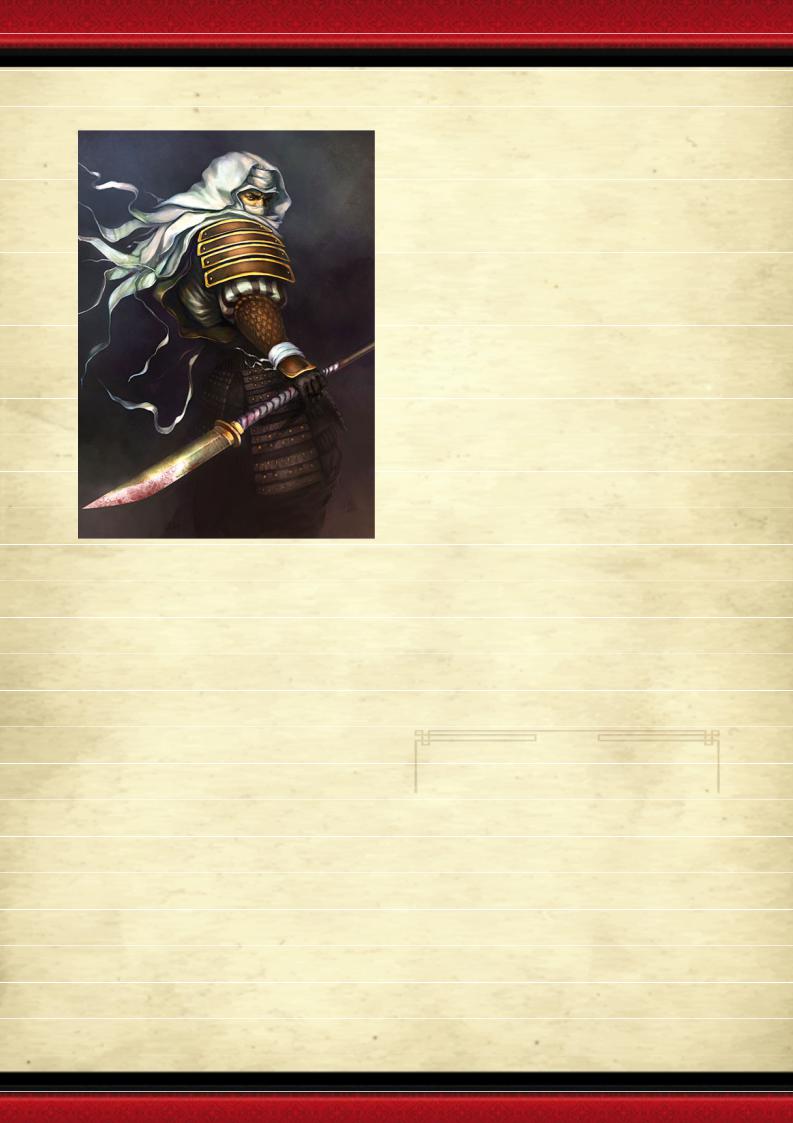
WA RRIOR MONKS
Monks occupy a tenuous position In Nippon's social order. As a rule, they are not forthcomi ng about their past, and it is considered almost blasphe mous to inquire. A monk has left his old life beh ind. The fact that some were peasants and others samurai makes interacting with them difficult, as one never knows what station should be afforded a monk. Given the uncertainty and their position as religio us figures, the honourable thing to do when interacting with a monk is to treat him with respect and admiration . This mindset is common to all but the most dishonourable samurai. While samurai feel some uncertainty w hen interacting with monks, the peasants simply revere them. Monks are teachers as much as anything else, and they treat all people equally. Also, many monasteries send their adherents into villages and towns to aid heimin and hinin with menial tasks.
Monks represent the entirety of Nippon's religion, which is a surprisingly diverse, eclectic, and elaborate institution with three distinct facets. Wh ile an Imperial decree technically links two of these fac ets together, and the third is so widely accepted that none dispute it, the truth is that the three do not fit together particularly well. Generally speaking, the average in dividual, including monks, selects an aspect he finds most desirable and uses that as the basis of his devotion.
Deep in the inaccessible areas of Nippon lie the many mountain retreats of religious warrior m onks. In these
martial monasteries, monks not only study religious and academic texts, but also a variety of martial arts. The studying of martial arts is seen as a means to improve oneself mentally and spiritually, not just physically, and these monks show a skill and dedication that surpasses eve n the samurai of the military aristocracy – and in deed many Samurai abandon their feudal lord to learn from these master monks. Warrior monks are t he de facto private armies of the secluded monasteries, and are fundamentally similar in many respects to t he religious templars of the Old World.
They are more militant than holy, and receive very little religious instruction. Instead they are trained in the art of fighting. Warrior M onks defend their monastery against attacks and advance its political claims in the outside world. They are subject to the leader of their temple.
They are often charged with defending their temples in times of conflict, but they can also expect to strike against enemy incursions, to hunt down evil monsters terrorizing the countryside, o r to recover a relic that is sacred to their order. They welcome all challenges as tests of their prowess and, secondarily, their faith. Warrior Monks mix martial prowess with divine power that grants them the ability t o heighten their strength and speed in battle, and prot ection from mental and bodily harm. Very experienced sohei can shrug off physical damage and ignore certain magical effects.
Warrior monks live a life of strict discipline and obedience to their orders. M any join their orders as children, and become sohei when they demonstrate strength of both body and mi nd that lends itself to the temple's defence. Often, thou gh, young men and women who show little prom ise for the contemplative life of the monk are the ones selected to become sohei.
|
M WS BS S T W I A Ld |
||||||||
Warrior Monk |
4 |
4 |
3 |
3 |
3 |
1 |
4 |
1 |
8 |
Sohei |
4 |
4 |
3 |
3 |
3 |
1 |
4 |
2 |
8 |
TROOP TYPE: Infantry.
SPECIAL RULES: Imm une to Psychology, Magic
Resistance (1).
Martial Arts: Warrior Mon ks are skilled combatants, studying the old martial arts of Nippon daily. They have learned to bring use of this to on the battlefield, fighting with fist and feet as well as any weapon they might carry.
Warrior Monks may re-roll failed rolls to Hit and Wound in Close Combat.
58

YAMABUSHI
Nippon is inhabited by a people who fe el bound to their land by a sacred ancient duty. The structure of society is rigid; and so too are Nippone se religious observances. In monasteries scattered a cross Nippon, shaven-headed acolytes toll brazen bell s over silent courtyards. A life of study and ritual under gingko trees and behind paper panels has gone unch anged for many, many long years.
The early history of the priesthood is lost in the mists of time. As far as the peasants are conc erned, the moss grown roads of heavy stone leading to the temples of the gods have existed since time began. The people of Nippon know of their religion through hearsay and grandmothers’ tales; the monks keep a certain distance from all the rest of the Nipponese, espe cially the peasants. Some monks wander round an d preach, going barefoot from town to town, or even overseas, and are fairly universally respected.
Besides their ability to affect the gods t hemselves, and popular opinion and morale besides, the monks’ abilities as warriors encourage the samu rai clans to keep as many monasteries as possible on their side. Monks in the monasteries are principally scholars, but train bare fisted and barefooted. They c an be called upon to go into battle if lands near their monastery, or their monastery itself is threatened. Mo re deadly, up in the mountains of Nippon various warrio r sects known as Yamabushi train more rigorously and more violently, slaying oni in the blackest de pths of the forests. Their rituals include walking across beds of red-hot coals, chanting while sitting und er ice-cold waterfalls and hanging from their feet f rom the edges of cliffs. The peasantry and even the mo nks regard these men with a certain respect, and fear their supposedly magical abilities.
These hermits are like wandering lay-pr iests who live alone in secluded mountains. Those with a smattering of Nipponese might suppose that "Yamabushi" means "mountain warrior", but in fact the second character is written differently and means "one who walks in the mountains".
He seeks mastery of certain arcane combat techniques and magic arts, the lore of herbs and na ture, and ultimately satori, or Enlightenment, thro ugh the study of Zen.
These men and women trace the origin of their tradition as a militaristic religious order back to hermits who went up to the mountain regions in search of divine inspiration and supernatural powers. They are more tactically astute and combat traine d than their generally non-martial brothers, but are no less stubborn in defence of their religion. Their traini ng as warriors helps teach them the ways of discipline and control of the mind, and this is looked on well by the daimyo classes and Shogunate, for various reas ons.
59
|
M WS BS S |
T W I A Ld |
|||||||
Yamabushi |
4 |
4 |
4 |
4 |
4 |
2 |
4 |
2 |
8 |
TROOP TYPE: Infantry ( Character).
SPECIAL RULES: Imm une to Psychology, Magic
Resistance (2), Martial Arts.
Prayers of the Kami: Yama bushi know the three Prayers listed below. Prayers are innate bound spells (power level 3). All Prayers are augment spells. In addition, the Yamabushi ma y channel Power and Dispel dice just like a Wizar d.
•Prayer of Invigouration: One friendly character within 12” of the Yamabu shi will regain all Wounds previously lost during the battle.
•Prayer of Protection: One friendly character within 12” of the Yamabushi will gain a 4+ Ward save until the start of the caster’s nex t Magic phase.
•Prayer of Potency: One f riendly character within 12” of the Yamabushi may re-roll all failed rolls To Hit and To Wound in clos e combat. Remains in play.
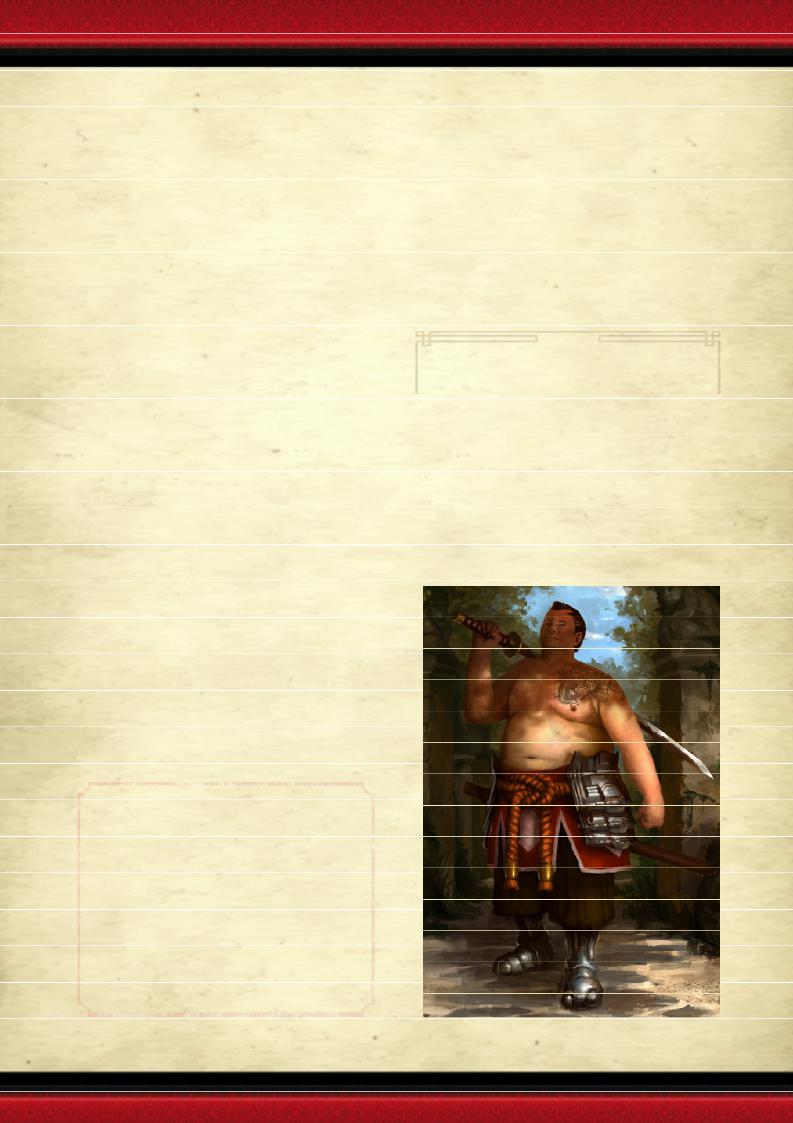
SU MO WARRIORS
Before Emperor Yamakyuki, many noblemen of Nippon lived in constant danger of assassination, whether from the hired killers of other n oblemen or the ambitious members of their own family. In the complex web of family and group loyalty that is Nipponese society it was sometimes be st to employ outsiders, individuals who have no clan or family ties to interfere with their personal loyalty.
The Sumo Warriors were such men, sep arated from their families in childhood and raised in special schools they are sold to any noble who can afford their services. Iron muscled frames sheathed in mountains of fat, the Sumo Warriors are the products of a strange bodybuilding regimen of force-feeding and tortuous strength and endurance routines.
In the performance of their bodyguard d uties Sumotori was expected to interpose themselves b etween their master and potential threats, in effect providing them a living shield of unyielding flesh. This dedication to duty and complete lack of concern for t heir own safety made them a formidable foe on the batt lefield.
After Yamakyuki took the throne and unified Nippon, the practice of Sumo bodyguards was re dundant, as most Daimyos began to hire their most loyal Samurai to act as their bodyguards instead. Sum o Warriors instead became sportsmen in the very p opular sport of Sumai.
Sumo wrestlers go through intense puri fication and meditation rituals before a sumo bout, and spectators come for the ceremony as much as the s port. An actual bout of sumo is over in seconds, as two massive wrestlers slam into one another with the intent of knocking the opponent off his feet or pu shing him out of the ring. Matches are separated into four categories according to the skill and reputation of the wrestlers. In ascending order, these are juryo, maegashira, sanyaku, and yokuzuna. The Imperial Court only allows bouts of yokuzuna. Sumo tournaments take plac e between two teams of wrestlers who perform sevente en bouts before the Emperor and his entourage.
The Uruchi Sumai is an advanced scho ol of training, and is considered to be a set of clan secret techniques. The Uruchi Clan rarely makes exceptions to this, and only a few lucky outsiders have b een taught them.
Testing their strength is a favourite pastime of many Uruchi samurai, and is one of the mo re popular forms of duelling when facing another Uruchi. Sumai is a commonly accepted method of duelling in Nippon, a method with which the Uru chi are very familiar. They respect and rely on this form of competition when dealing with other clans to a high degree, and have several dojo dedicated to training different techniques.
A beautifully crafted master work bow goes to the victor whereupon they receiv e an invitation from the Imperial court to perform bugaku, a complex ritual of ceremonial songs and dances ; the champion dances while twirling the prize bow.
While the Sumo Warriors ar e sportsmen most of the time, they still train like any other Samurai. In times of war, these massive warriors go into battle wielding nodachi swords, easily capable of cutting though a knight and horse with a single blow, making them excellent shock troops.
|
M WS BS S T W I A Ld |
||||||||
Sumo Warrior |
4 |
4 |
3 |
4 |
4 |
1 |
3 |
1 |
8 |
Yokosuna |
4 |
4 |
3 |
4 |
4 |
1 |
3 |
2 |
8 |
TROOP TYPE: Infantry.
SPECIAL RULES: Way of the Warrior,
Kenjutsu, Death before Dis honour.
Unstoppable Force: When Sumo Warriors charge, they are an unstoppable forc e of mass and muscles that can tear through a regiment with ease.
On any turn that Sumo Warriors charges, the enemy must re-roll successful Break Tests.
60
